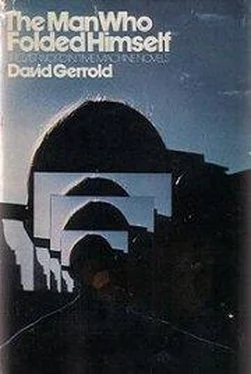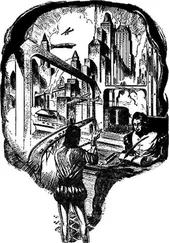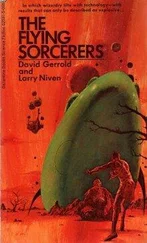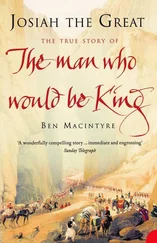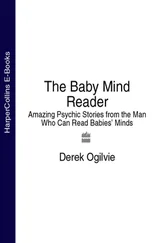Well, let’s see…
I could put something in the timebelt itself, a date and location perhaps, then substitute it into Uncle Jim’s package…
No. That part of my past no longer exists in this world. I excised it — remember?
Well, then, how about if I left a message far in the past…
No, that wouldn’t work. Look at the trouble the Coke bottle almost got me into. Where would I leave it where only I would discover it? How would I — how would he — know where to look for it? How could I even be sure of its enduring for the several thousand years it might have to? (Besides, I’m not sure it would exist in any of the timelines that branched off before I got myself into this dead end. Changes in the timestream are supposed to be cumulative, not retroactive.)
I guess the answer to my question about getting a message across the timelines is obvious: I don’t. There simply isn’t any working method of trans-temporal communication. At least none that I can think of that’s foolproof.
But that doesn’t mean I still can’t meet another version of myself.
I meet different versions of myself all the time. The mild variants. The only reason I haven’t run into a distant variant is that we haven’t been tramping a common ground.
If I want to find such a variant, I have to go somewhere he’s likely to be.
Suppose that somewhere there’s another me — a distant me — who’s thinking along the same lines: he wants to meet a Daniel Eakins who is widely variant from himself.
What memories do we have in common?
Hmm, only those that existed before we were given the timebelt…
That’s it, of course!
Our birthday.
* * *
I was born at 2:17 in the morning, January 24, 1956, at the Sherman Oaks Medical Center, Sherman Oaks, California.
Of course, in this timeline, I hadn’t been born — wouldn’t be born. Something I had done had excised my birth; but I knew the date I would have been born and so did every other Dan.
It was the logical place to look.
In 1977 the Sherman Oaks Medical Center was a row of seven three- and four-story buildings lining Van Nuys Boulevard just north of the Ventura Freeway.
In 1956 it comprised only two buildings, one of which was strictly doctors’ offices.
I twinged a little bit as I drove down Van Nuys Boulevard of the mid-fifties. I’d been spending most of my time in the seventies. I hadn’t realized…
The two movie theaters were still the Van Nuys and the Rivoli. Neither had been remodeled yet into the Fox or the Capri — and the Capri was soon to be torn down. Most of the tall office buildings were missing, and there were too many tacky little stores lining the street.
And the cars — my god, did people actually drive those things? They were boxy, high, and bulky. Their styling was atrocious — Fords and Chevys with the beginnings of tail fins and double headlights; Chryslers and Cadillacs with too much chrome. And Studebakers — and DeSotos and Packards!
There was a big vacant field where I remembered a blue glass, slab-sided building that stretched for more than a block. But the teenage hangout across the street from it was still alive, still a hangout.
I twinged, because in 1977 I had left a city. This was only a small town, busy in its own peaceful way, but still a small town. Why had I remembered it as being exciting?
As I approached the Medical Center itself, I realized with a start that something was missing. Then it hit me — in 1956 the Ventura Freeway hadn’t been built yet, didn’t extend to Van Nuys Boulevard. (I wondered if the big red Pacific Electric Railroad cars were still running. I didn’t know when they had finally stopped, but the tracks had remained for years.)
I’d seen Los Angeles in its earlier incarnations, but the Los Angeles of 1930 had always seemed like another city, like a giant Disneyland put up for Danny the perpetual tourist. It wasn’t real. But this — this I recognized. I could see the glimmerings of my own world here, its embryonic beginnings, the bones around which the flesh of the future would grow.
I parked my ’76 ’Vette at the corner of Riverside Drive and Van Nuys, ignoring the stares of the curious. I’d forgotten what I was doing and brought it back with me. So what? Let them think it was some kind of racer. I couldn’t care less. I was lost in thought.
I’d been living my whole life around the same three years. Sure, I’d gone traveling off to other eras, but those had been just trips. I’d always returned to 1977 because I’d always thought of it as home.
I’d folded and compressed my whole life into a span of just a few months.
Consequently, I lived in a world where the landscape never changed. Never.
They’d been building the new dorm for the college for as long as I could remember. They’d been grading for the new freeway forever. (Oh, I knew what the finished structures would look like. I’d even driven the new freeway; but the time that I knew as home was frozen. Static. Unchanging.)
I’d lived in the same year for over ten subjective years. I’d grown too used to the idea that home would endure forever. For me, the San Fernando Valley was a stable entity. I’d forgotten what a dynamically alive city it was because I’d lost the ability to see its growth—
—because I no longer traveled linearly through time.
Other people travel through time in a straight line. For them, growth is a constant process, perceived only when the changes are major ones, or when there is something to compare them against.
To me, growth is—
—it doesn’t exist. Every time I jump, I expect the world to change. I never equate any era with any other.
Until now, that is.
I knew this city; I’d grown up here — but I’d forgotten that it existed. I’d forgotten what it was like to be a part of the moving timestream, to grow up with a city, to see it change as you change…
I’d forgotten so much.
So much.
* * *
There was no one at the hospital, of course.
That is, I wasn’t there — there were no other versions of Daniel Jamieson Eakins waiting to meet me.
I should have known it, of course. My birthday fell within the range of changes I’d been making. I was the only me in this timeline. If I wanted to find another me, I’d have to go outside the scope of my temporal activity. I’d have to go into the past. Deep into the past.
The only way to escape the effects of any change is to jump back to a point before it happened.
I’d been making changes for the past two hundred years. If I was to meet a variant Dan, we’d both have to go back beyond that span.
But how far back?
I stood by the car, jingling my keys indecisively. The one location I was sure of was this hospital; the one date, my birthday.
Okay—
This spot. The middle of the San Fernando Valley.
The date: January 24. My birthday.
—one thousand years ago. Exactly.
I got in the car, set the timebelt to include it, and tapped twice—
* * *
POP!
I’d been expecting it, but the jump-shock was still severe. The pain of it is directly proportional to the amount of mass making the jump.
Rubbing myself ruefully, I opened the door and got out.
My Corvette and I were in the middle of a flat brown plain. Scraggly plants and bushes all around. I recognized the Hollywood Hills to the southeast. Crisp blue sky. Unreal; no smog. And dry, almost desertlike ground stretching emptily to the purple-brown moun-
tains that surrounded the valley. The San Bernardino range had never looked so forbidding; those black walls at the far northeast end were undimmed by human haze, undwarfed by human buildings, unscarred by human roads. I gazed in awe; I’d never really noticed them before.
Читать дальше
